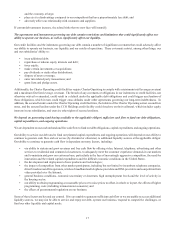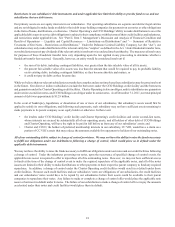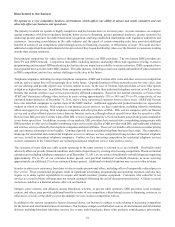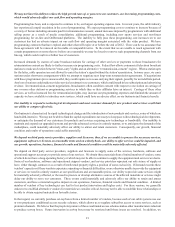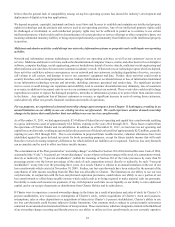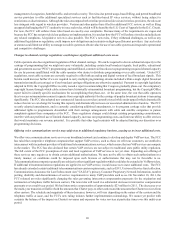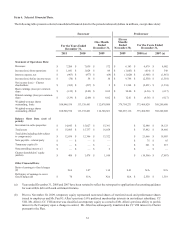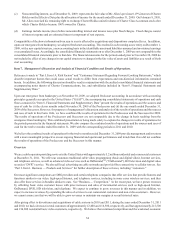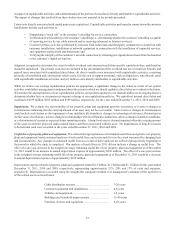Charter 2011 Annual Report Download - page 39
Download and view the complete annual report
Please find page 39 of the 2011 Charter annual report below. You can navigate through the pages in the report by either clicking on the pages listed below, or by using the keyword search tool below to find specific information within the annual report.
27
Item 1B. Unresolved Staff Comments.
None.
Item 2. Properties.
Our principal physical assets consist of cable distribution plant and equipment, including signal receiving, encoding and decoding
devices, headend reception facilities, distribution systems, and customer premise equipment for each of our cable systems.
Our cable plant and related equipment are generally attached to utility poles under pole rental agreements with local public utilities
and telephone companies, and in certain locations are buried in underground ducts or trenches. We own or lease real property for
signal reception sites, and own our service vehicles.
Our subsidiaries generally lease space for business offices. Our headend and tower locations are located on owned or leased parcels
of land, and we generally own the towers on which our equipment is located. Charter Holdco owns the land and building for our
principal executive office.
The physical components of our cable systems require maintenance as well as periodic upgrades to support the new services and
products we introduce. See “Item 1. Business – Our Network Technology.” We believe that our properties are generally in good
operating condition and are suitable for our business operations.
Item 3. Legal Proceedings.
Patent Litigation
Ronald A. Katz Technology Licensing, L.P. v. Charter Communications, Inc. et. al. In 2006, Ronald A. Katz Technology Licensing,
L.P. filed a lawsuit against Charter and other parties in the U. S. District Court for the District of Delaware alleging that Charter
and the other defendants infringed its interactive call processing patents. Charter denied the allegations raised in the complaint. In
2007, the lawsuit was combined with other cases filed by Katz in a multi-district litigation proceeding in the U.S. District Court
for the Central District of California for coordinated and consolidated pretrial proceedings. In 2010, the court denied Katz's motion
for summary judgment, struck two affirmative defenses that Charter had raised, invalidated one of the nine remaining claims Katz
had asserted and entered a ruling limiting Katz's damages claims. In subsequent rulings related to other defendants, the court
invalidated certain patent claims that are currently asserted against Charter. A consolidated appeal involving other co-defendants
has since concluded, with the U.S. Court of Appeals for the Federal Circuit confirming invalidity of certain claims and remanding
certain rulings back to the district court for further consideration. Based on the Federal Circuit's opinion, the district court has
ordered additional summary judgment briefing and some limited pre-trial briefing. When all of these pre-trial proceedings are
completed, any matters remaining for trial will be transferred back to the District Court in Delaware. No trial date has been set.
Charter has also initiated a reexamination with the U.S. Patent Office challenging the validity of one of the patent claims asserted
against it. Charter continues to vigorously contest this matter.
Rembrandt Patent Litigation. In 2006, Rembrandt Technologies, LP filed two lawsuits against Charter and other parties in the
U.S. District Court for the Eastern District of Texas, alleging that each defendant's high-speed data service and systems for receipt
and retransmission of Advanced Television Systems Committee digital terrestrial broadcast signals infringe nine patents owned
by Rembrandt. In 2009, Rembrandt executed a covenant not to sue agreeing to not sue Charter and the other defendants on eight
of the contested patents that were then stipulated for dismissal from the case. On September 7, 2011, the court entered final
judgment of non-infringement in favor of Charter and the other defendants on the eight patents stipulated for dismissal and on the
remaining patent. On September 28, 2011, Rembrandt appealed to the U.S. Court of Appeals for the Federal Circuit for review
of the judgment on that remaining patent. Charter continues to vigorously defend this appeal.
We are also defendants or co-defendants in several other unrelated lawsuits claiming infringement of various patents relating to
various aspects of our businesses. Other industry participants are also defendants in certain of these cases.
In the event that a court ultimately determines that we infringe on any intellectual property rights, we may be subject to substantial
damages and/or an injunction that could require us or our vendors to modify certain products and services we offer to our subscribers,
as well as negotiate royalty or license agreements with respect to the patents at issue. While we believe the lawsuits are without
merit and intend to defend the actions vigorously, no assurance can be given that any adverse outcome would not be material to
our consolidated financial condition, results of operations, or liquidity.


